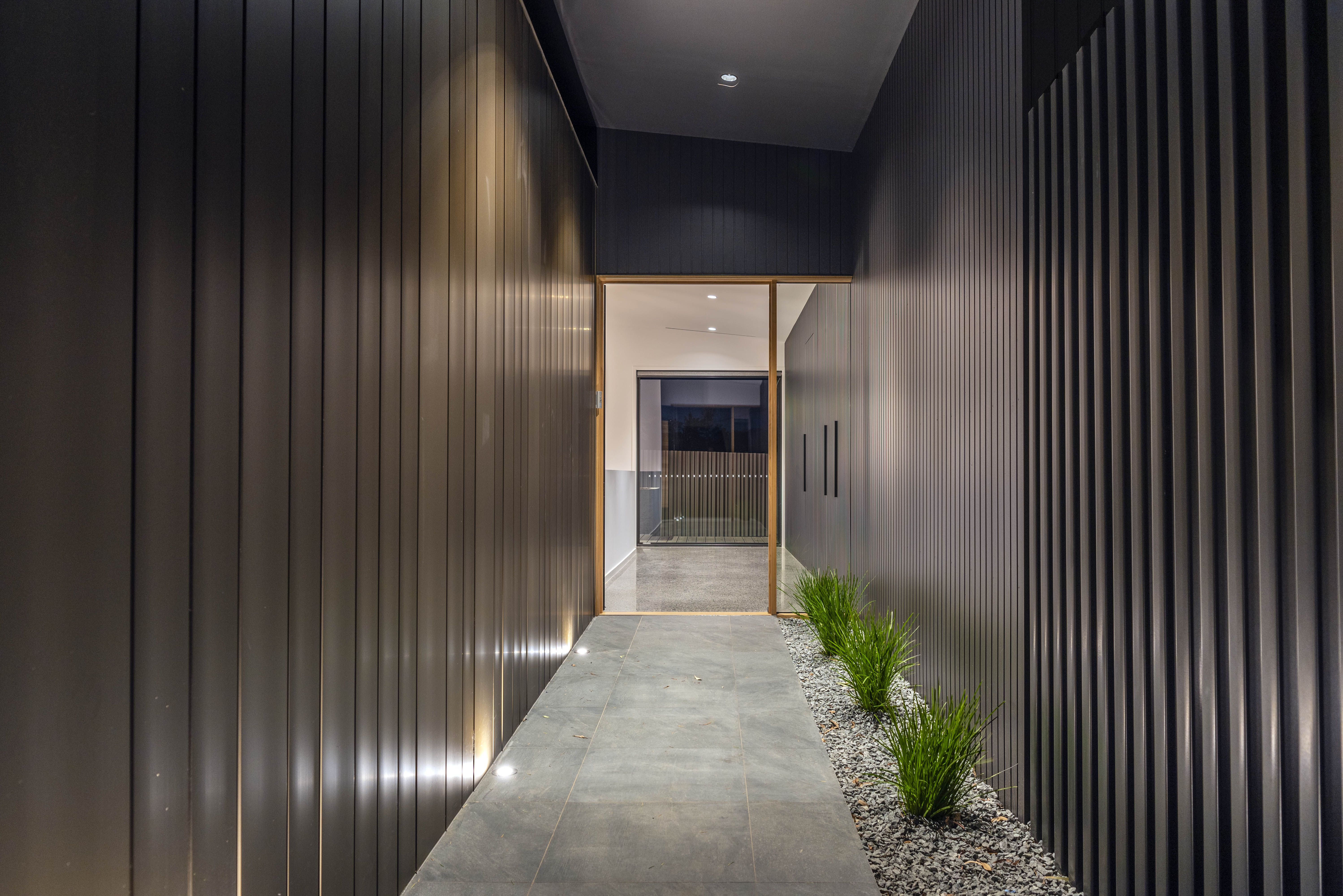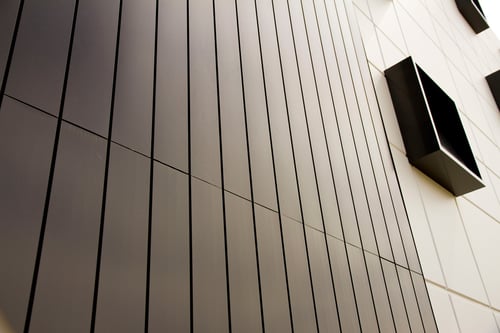From Concept to Completion: How to Choose and Install Interlocking Aluminium Systems

Interlocking aluminium cladding is a defining feature of modern Australian architecture, used in a wide range of civic, residential and commercial projects. These systems provide architects with design flexibility, builders with cost-effective solutions and installers with efficient assembly. This guide compares interlocking panels to flatlock and cassette alternatives, highlighting key considerations, including installation, maintenance and compliance.
What Is Interlocking Aluminium Cladding?
Interlocking aluminium panels feature extruded profiles with male-to-female joints that snap or slide into place, creating clean, continuous shadow lines. Panels are mounted on a ventilated substructure that allows air circulation behind the façade, supporting moisture management and long-term performance. Concealed fixings maintain an uninterrupted, polished appearance.
Widely specified for commercial towers, civic centres and residential buildings, interlocking systems provide linear definition, flexible orientation and resilience to environmental stresses. Their durable, low-maintenance design ensures façades remain visually striking over time.
Why Choose Interlocking Panels?
Interlocking aluminium cladding delivers both aesthetic refinement and technical performance:
-
Installation efficiency: Male-to-female joints eliminate the need for clips, brackets or folds, streamlining assembly and offering faster installation than cassette systems.
-
Concealed fixings: Hidden fasteners maintain clean, professional lines.
-
Design consistency: Extruded panels offer rigidity and minimise oil canning, especially with darker colours.
-
Durability and low maintenance: Aluminium or steel construction withstands harsh environments while smooth pre-finished surfaces reduce upkeep.
-
Design flexibility: Panels can be installed horizontally, vertically or diagonally, with shadow lines adding depth. Mixing colours and finishes enables bold contrasts or seamless continuity.
-
Ventilated cavity: Air circulation behind panels enhances thermal efficiency, reduces moisture build-up and prolongs façade life.
-
Sustainability: Aluminium is highly recyclable, and panels can be demounted and reused, reducing embodied carbon.
-
Scalability: Systems perform consistently across small residential builds and high-rise developments.
Stryum Interlocking Aluminium Panels
Fairview’s Stryum interlocking aluminium panels provide a benchmark solution. These solid aluminium panels offer sharp shadow lines, multiple profiles and finishes, and the performance of premium-grade materials.
-
-
Australian-made quality: 100% Australian-owned and manufactured with premium raw materials and finishes for exceptional reliability and longevity.
-
Widest design range: Stryum offers the largest selection of colours and profiles on the market, with custom ranges available to suit specific architectural visions.
-
Compliance and performance: Non-combustible panels meet AS 1530.1, AS 1530.3 and AS 4284, with rigorous testing for fire, impact and wind resistance.
-
Design flexibility: Multiple widths, profiles and finishes enable tailored shadow lines, layered textures and striking façades.
-
Efficient installation: The tab-and-hook mechanism allows panels to interlock with pre-loaded strength, overlapping to conceal fixings. Minimal fabrication and elimination of external sealants reduce installation time and labour costs.
-
Practical detailing: A specially designed selection of trims allows every architectural requirement to be met while maintaining a polished appearance.
-
Project support: Backed by a 15-year warranty, national delivery and technical expertise, giving confidence for both large-scale and intricate applications.
-
Selecting the Right System for Your Project
Cladding systems define not only the performance of a building envelope but also its visual identity. The choice between interlocking, flatlock and cassette panels comes down to installation efficiency, design intent and long-term performance. Understanding their differences helps architects and builders select the right system for each project.
Systems at a Glance:
| System | Construction Method | Aesthetic Outcome | Best Suited For |
|---|---|---|---|
| Interlocking | Extruded aluminium profiles with male–female edges, fixed directly through the female leg into battens or top hats | Deep shadow gaps, crisp lines, sharp architectural expression | Premium residential, commercial and civic projects across varied heights |
| Flatlock | Folded sheet metal panels hook into one another, fixed through folded edges | Narrower depth provides a subtle shadow line | Low- to mid-rise residential, boutique commercial or decorative façades |
| Cassette | Folded box-shaped panels fixed to Z angles and top hats; joints sealed | Large-format panels with pronounced shadow lines between individual panels | Large-scale commercial, industrial or civic buildings |
Each façade system offers distinct advantages, enabling architects to align material choices with project intent.
-
Stryum Interlocking: Prominent, defined shadow lines for façades with strong architectural character. Extruded aluminium profiles maintain shape and minimise oil canning, especially in darker colours.
-
Vitradual Cassette: Wide-format panels create a flatter, monolithic look, ideal for commercial towers and civic buildings with uninterrupted wall coverage.
-
Vitracore G2 Cassette: Lightweight bonded panel system providing similar cassette aesthetics with easier handling and faster installation, suited for projects prioritising cost efficiency and compliance.
Fairview’s portfolio ensures that architects can match their vision with performance, whether seeking the crisp articulation of interlocking profiles or the expansive continuity of cassette cladding.
How to Install Interlocking Cladding: From Preparation to Finishing Touches
Below, we guide you through a step-by-step process for installing aluminium cladding to help you better understand the procedure. Please always refer to the supplier's installation manuals to ensure a secure, safe and high-performing installation.
1. Sub-framing: Fix S battens to framing. Correct alignment ensures consistent shadow lines and long-term performance.
2. Panel Installation: Align the first panel through its female leg. Each new panel slots over the previous female edge and is fixed through its own female leg. Maintain alignment across the façade.
3. Detailing: At corners, window reveals and penetrations, install purpose-designed trims to ensure weather protection and a polished finish.
For detailed diagrams, tolerances, and step-by-step illustrations, see the Stryum Installation Guide.
Maintenance and Lifecycle Considerations
Proper care ensures aluminium panels maintain appearance and performance:
-
Cleaning: Wash panels periodically with mild detergent and soft cloths. Avoid abrasive tools.
-
Inspections: Check fixings, sealants and surfaces regularly. Address minor issues promptly.
-
Lifecycle: Correctly installed systems are highly durable. Panels can be demounted and recycled at end of life.
Troubleshooting: Thicker panels, such as Stryum, reduce oil canning. Ensure joints are sealed and sub-frame drainage is installed correctly to prevent water ingress.
When to Engage a Certified Supplier for Project Success
From design to completion, Fairview provides tailored technical advice, compliance guidance and project-specific recommendations. We assist with panel selection, sub-framing, detailing, and access to samples and documentation, ensuring your system delivers optimal performance and aesthetic excellence.
Ready to specify Interlocking Aluminium Cladding?
Interlocking aluminium cladding strikes a balance between architectural freedom, durability, and compliance. By evaluating building type, environmental loads, compliance requirements, and aesthetic intent, specifiers can confidently select the right interlocking panel system. For architects, builders and installers, aluminium wall cladding systems like Stryum provide reliable, versatile solutions that perform for decades.
Request a sample or contact our team to bring your project from concept to completion.


